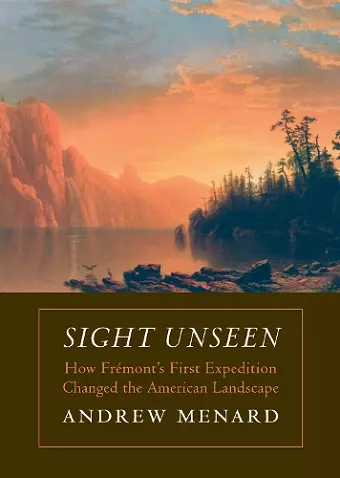Sight Unseen
How Frémont's First Expedition Changed the American Landscape
Format:Paperback
Publisher:University of Nebraska Press
Published:1st Sep '18
Currently unavailable, and unfortunately no date known when it will be back

John C. Frémont was the most celebrated explorer of his era. In 1842, on the first of five expeditions he would lead to the Far West, Frémont and a small party of men journeyed up the Kansas and Platte Rivers to the Wind River Range in Wyoming. At the time, virtually this entire region was known as the Great Desert, and many Americans viewed it and the Rocky Mountains beyond as natural barriers to the United States. After Congress published Frémont’s official report of the expedition, however, few doubted the nation should expand to the Pacific.
The first in-depth study of this remarkable report, Sight Unseen argues that Frémont used both a radical form of art and an imaginary map to create an aesthetic desire for expansion. He not only redefined the Great Desert as a novel and complex environment, but on a summit of the Wind River Range, he envisioned the Continental Divide as a feature that would unify rather than impede a larger nation.
In addition to provoking the great migration to Oregon and providing an aesthetic justification for the National Park system, Frémont’s report profoundly altered American views of geography, progress, and the need for a transcontinental railroad. By helping to shape the very notion of Manifest Destiny, the report became one of the most important documents in the history of American landscape.
“[A] sharp and canny synthesis. . . . Most impressive in Sight Unseen is the meticulous way Menard makes his case that his imaginative transformation was a textual one.”—Robert Thacker, Western American Literature
"Crisply written, deliciously illustrated."—Ryan Boyd, Great Plains Quarterly
"Sight Unseen is a rigorously researched, exceptionally astute, and well-reasoned interdisciplinary study of a report that defined America's emerging ideology of progress. It is a splendid contribution to the historiography of both Frémont and nineteenth-Century America."Fred MacVaugh, Nebraska History
"[Sight Unseen is] a well-written work revealing an essential part of the history of the North American continent."—G.J. Martin, Choice
"Through the imaginative eyes of Frémont, Menard makes significant strides in linking the words of the explorer and naturalist to the cultural concept that would shape the future land use and settlement of the American West."—Camden Burd, Historical Geography
"Anyone interested in how Americans transformed western lands from obstacles into symbols of national achievement will find much of value in Menard's work."—Jared Orsi, Kansas History
“Eloquent, lively, and learned, with an intellectual breadth as wide as a Rocky Mountains horizon, Andrew Menard’s Sight Unseen ably reconnoiters geographies of both imagination and terra firma. This fascinating book recovers the American West as John Frémont found it and shows us how the explorer taught us to see American landscapes—and America itself—anew.”—Tom Chaffin, author of Pathfinder: John Charles Frémont and the Course of American Empire
“Sight Unseen is a book for anyone who loves maps, landscape, and historical intricacy. . . . Anchored by the image of the explorer waving his nation’s flag from a mountain peak, Menard’s account of Frémont’s expedition enlivens the rhetoric of a triumphal national narrative. Like the explorer’s Report, Sight Unseen melds scientific, symbolic, and aesthetic views of a nation that knew no bounds.”—Lucy R. Lippard, author of Down Country, winner of the Caroline Bancroft History Prize
ISBN: 9781496205599
Dimensions: unknown
Weight: unknown
288 pages